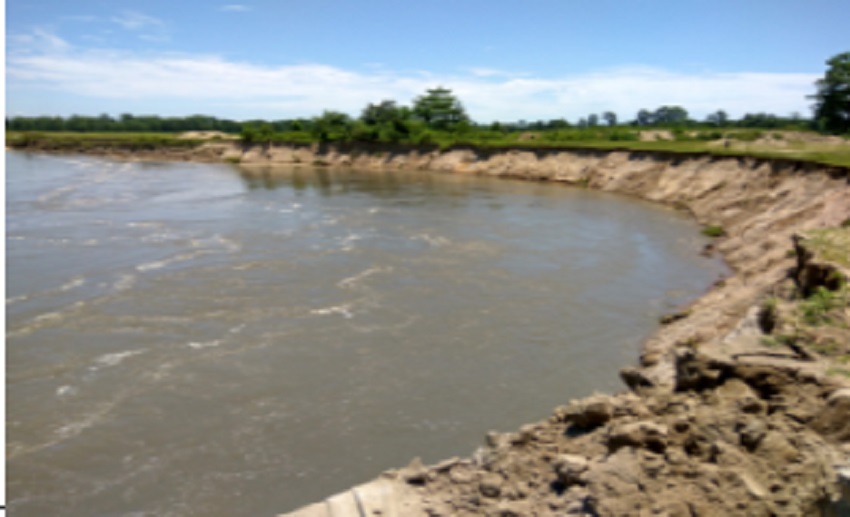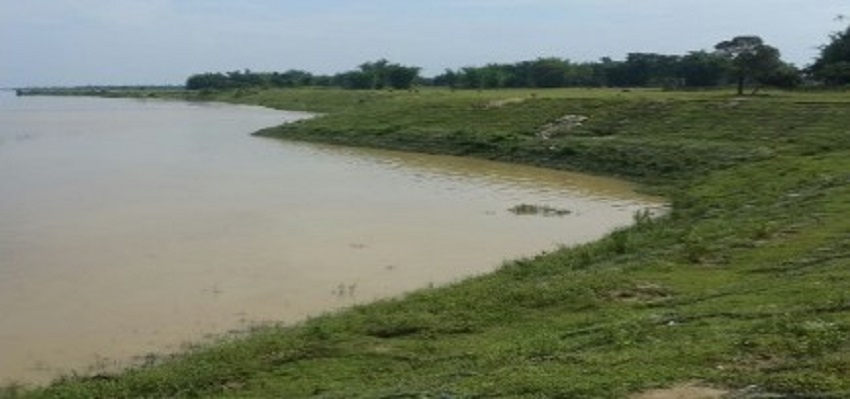Arunachal | Subansiri Lower H E Project: Downstream River Bank Protection Solution– PART-2: Design
Erosion Protection Measures for Subansiri River – Design Solutions:
The comprehensive study of river morphology, erosion pattern and channel migration pattern of river Subansiri by the IIT Roorkee Team had highlighted the total land lost due to erosion, excluding forest land, during the period 2008-2010 and 2010-2014 was found to be 3.382 km2 per year and 2.07 km2 per year. It was also observed from the Data Geo Referencing and Image Processing of the satellite images for the years 2008 and 2010 that –
1. Total land lost to erosion is found to be 6.764 km2 and channel abandonment/ deposition stands at 2.021 km2;
2. Maximum value of bank retreat on the left bank comes to be 634.799 m and the maximum value of channel deposition on the left bank stands at 666.102 m; and
3. Maximum value of bank retreat on right bank comes to be 741.50 m and the maximum value of channel deposition on the Right bank stands at 789.599 m.

Protection with Gabions and Geo Bags
These aspects had highlighted the need for a robust and efficient river management action plan to arrest huge valuable land losses to erosion.
As per IIT Roorkee 2013 Report, the initial protection measures suggested, considering the variation in river bank slope and height, were categorized into the following three solutions:
Protecting the bank with Gabion Trail Duke and RCC Jack Jetty
In this solution, the RCC jack jetty between two gabion trial dykes enables the breaking up of the erosive flow of vortices and induces sedimentation along river banks while the gabion trial dyke protects the bank from further erosion. In this solution, a Gabion mattress, which will function as an apron, is also provided to provide protection against scouring action.

Sourced River Bank before protection work.
Protecting the bank with Sack Gabions, Gabion Box and Gabion Mattresses with 3-dimensional erosion control mat
In this solution, sack gabion filled with boulders are to be placed below the Lowest Water Level (LWL) to protect the river bed against erosion. In addition to this, a gabion mattress can be placed over the sack gabion so that it functions as an apron, providing protection against erosion. In case construction in dry conditions is possible, then gabions and erosion control mats can be used above the water level portion. This solution has been suggested for those locations where the water depth is high and the dry condition is not available for construction.
Protecting the bank with Sack Gabions and Gabions only
In this solution, sack gabions filled with boulders are to be placed below LWL to protect the river bed against any erosion. These sack gabions filled with boulders function as an apron. For that portion above water level, gabions and bio mat can be used, where construction in dry conditions is possible.
IIT Roorkee 2013 Report suggested the sack gabion filled with stones, based on the analysis of several alternatives - Sack gabions filled with rocks; Sack gabion lined with geotextile and filled with sand; Geotextile bags filled with sand; and Geotextile Tubes filled with local material – with the objective to provide a solid protection system that can withstand critical hydraulic forces including high velocity of the order of 5.0 m/sec or more. These alternatives were analyzed based on ease of installation, economics, and stability.
The above-mentioned proposed solutions were then revised in the IIT Roorkee 2014 with the following solutions:
- Bank Protection with Gabion Trail Dyke and RCC Jack Jetty - For Construction in Low Water Depth in non-monsoon season
- Bank Protection with 0.3m Gabion Mattress and RCC Jack Jetty - For Construction in Deeper Water Depth (2 to 5m) in Dry Season
In this solution, a gabion mattress is to be laid on the lower bank of the river followed by RCC jack jetties, which act as energy dissipaters. This solution has been proposed for those locations where water depth remains high and dry condition is not available for construction even in non-monsoon seasons.
- Bank Protection with 0.3m Gabion Mattress and RCC Jack Jetty - For Construction in Shallow Water Depth <2 m in Dry Season
This solution is similar to the solution mentioned above, however, due to the possibility of the dry working area the cost of installation may be lower.
- Bank Protection with Sack Gabions, and RCC Jack Jetty - For Construction in Deeper Water Depths 2 to 5m in Dry Weather Season
Sack gabions filled with boulders and RCC Jack Jetty can be adopted as the alternative solution for those locations where water depth is high and under water placement of Gabion Mattress is difficult. In this case, sack gabions filled with boulders are to be dumped below LWL to protect the river bed against any erosion.

Area stabilized after protection work.
It has been noted in the revised design that sacks gabions / rectangular gabions lined with geo-textile may be used as containers of sand, if the option is found to be more economical than stone-filled sack gabions in case of non-availability of the river or blasted boulders at the site.
DESIGN ADAPTED FOR DOWNSTREAM PROTECTION WORKS:
The work was proposed in three phases as follows:
- River Bank Protection/ Erosion Control Measures along the left bank up to Chauldhowa Ghat under Phase-I.
- River Bank Protection/ Erosion Control Measures along the right & left banks of River Subansiri downstream of Chauldhowa Ghat up to RD 23Kms. from Dam under Phase-II.
- Balance portion up to 30 Km. downstream of the Dam along the right & left banks of River Subansiri downstream of Chauldhowa Ghat under Phase III.
DESIGN CONSIDERED:
- The adopted design parameters conform to the site requirement of the Subansiri Lower HE Project.
- The adopted revisions were carried out from the original plan as proposed by IIT Roorkee, as per the reports issued on August 2013, November 2014 and January 2015, taking into account the emerging dynamic demand of the project.
- The recommendations of the Joint Steering Committee (JSC), joint survey report bring out the specific requirements subsequently adopted in the final design.
- The final design and drawing are also vetted by Technical Advisory Committee (TAC), a statutory technical expert body for Water Resource Department (WRD), Assam for Phase-III works -balance works upto 30 KM on 25.11.2019.
DESIGN PARAMETERS:
- Design Discharge: Data adopted as per site conditions and satellite imagery is admissible
- Mean particle dia= 0.35 mm
- Silt Factor: 1.04
- River Slope: 130 cm/km (upto 12 km d/s of Dam) and 24 cm/km (beyond 12 km)
- Velocity = 5.57m/s
- Scour Depth below (High Flood Level) HFL= 12.582 m
- Scour Protection Apron Length = 15.4811m
- To account for uncertainties of climate change effects on the unpredictable Himalayan flood flow regime as witnessed recently, an additional three-tier RCC Jack Jetty system is proposed at the end of the apron to mitigate scour by partially breaking – up erosive vortex flow.
Biswajit Basu is Director (Projects) at NHPC Ltd, Miren Kr Verma is General Manager at NHPC Ltd and A. N. Mohammed is Consultant at NHPC Ltd.

